Cuenca Area
Flight to Cuenca
Thursday, July 17, 2008: The second portion of the trip involves a completely different group. David Wolf has joined us as second guide, and there are 6 other participants. I had met most of them the previous evening. There were supposed to be 7 others (just enough for a second guide), but one was unable to make it.
The day started with an early trip to the airport for our flight to Cuenca. The flight itself was less than an hour. Much of the time it was cloudy, but we did get some views of the Andes, and the Andes poking through the clouds.
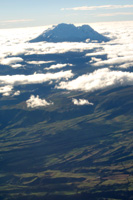 |
 |
| Andes | Cotopaxi Volcano |
|---|
Laguna Llaviucu
After checking into our hotel, we headed to the Laguna Llaviucu area of El Cajas National Park, which is at about 10,350' elevation. Shortly after we left the main road, a stop at a bridge yielded my first lifer of the day, a White-capped Dipper. Some Turquoise Jays were seen along the road by pretty much everyone else, but I couldn't manage to spot them. I kept getting Great Thrushes and Band-tailed Pigeons instead.
We soon arrived at the Laguna Llavuicu parking lot. At first, we birded the area near the parking lot. This was actually pretty productive. Lifers included Shining Sunbeam, Brown-bellied Swallow, Rufous-breasted Chat-Tyrant, Smoky Bush-Tyrant, and Tyrian Metaltail.
We walked down toward the lake, where we added Slate-colored Coot (also called Andean Coot), Andean Teal, the Andean form of Ruddy Duck (sometimes considered a separate species, although McCracken and Sorenson's study of stiff-tailed duck genetics suggests otherwise), and a glimpse of an Ecuadorian Rail! It's always exciting to see rails well, even when the AOU considers it a subspecies of our familiar Virginia Rail. The southern form of Sedge Wren, which may be split as Grass Wren, was also seen there. Its calls reminded me more of a Marsh Wren than Sedge Wren. By then it was time for lunch, so we returned uphill to the bus, huffing and puffing from the altitude. After the quick ascent to over 10,000 feet, I was just happy to not get mountain sick.
After lunch, we went for a walk all the way around the lake. We didn't get far from the parking lot before a nice flock appeared. It grabbed my attention as there were lifers all over the place, including Black Flower-piercer, Spectacled Whitestart, Pearled Treerunner, Masked Flower-piercer, Scarlet-bellied Mountain-Tanager, White-banded Tyrannulet, Streaked Tuftedcheek, Russet-crowned Warbler, Yellow-breasted Brush-Finch, and Superciliaried Hemispingus. As we proceeded down the road toward the lake, we added Rainbow Starfrontlet, White-throated Tyrannulet, Tufted Tit-Tyrant, Purple-throated Sunangel, Purple-backed Thornbill, and Blue-backed Conebill. A couple of Rufous Antpittas flashed across the path, but I was not able to see them well enough to count them.
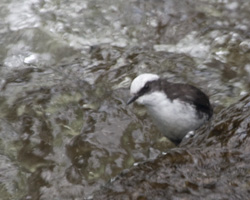 |
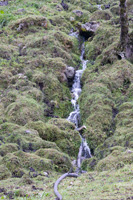 |
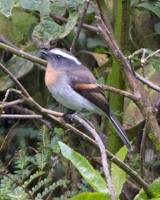 |
| White-capped Dipper | Little Waterfall | Rufous-breasted Chat-Tyrant |
|---|---|---|
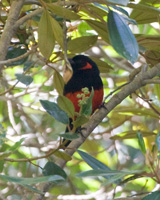 |
 |
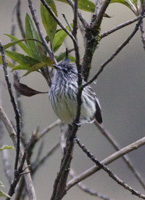 |
| Scarlet-bellied Mountain-Tanager | Cliffs at Laguna Llaviucu | Tufted Tit-Tyrant |
Laguna Llaviucu is quite scenic. It sits in a U-shaped valley, a sign of ancient glaciation, presumably during the last ice age. This might seem a little unexpected such a short distance south of the equator, but the high elevation (above 10,000 feet) makes up for it.
 |
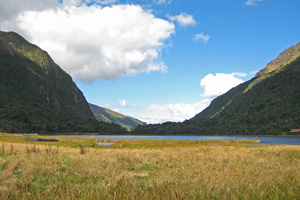 |
| Big Waterfall | Laguna Llaviucu |
|---|---|
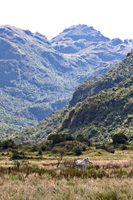 |
 |
| Horse and Hills | Andean Pampas Grass |
We continued around the lake, sometimes seeing more of the same birds, plus some Plain-colored Seedeaters. We got outstanding looks at several more Ecuadorian Rails, and a quick look at a Great Sapphirewing. A Brown-backed Chat-Tyrant was found in some of the reeds. A few other birds were spotted by other members of the group, but I didn't manage to see them.
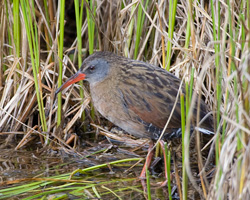 |
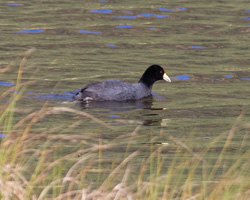 |
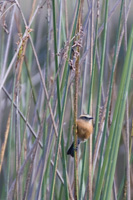 |
| Ecuadorian Rail | Slate-colored Coot | Brown-backed Chat-Tyrant |
|---|
Eventually we called it a day and returned to the hotel. Today's totals were 33 species including 27 lifers, making a grand total of 215 bird species with 138 lifers.
Hotel Pinar del Lago, Cuenca